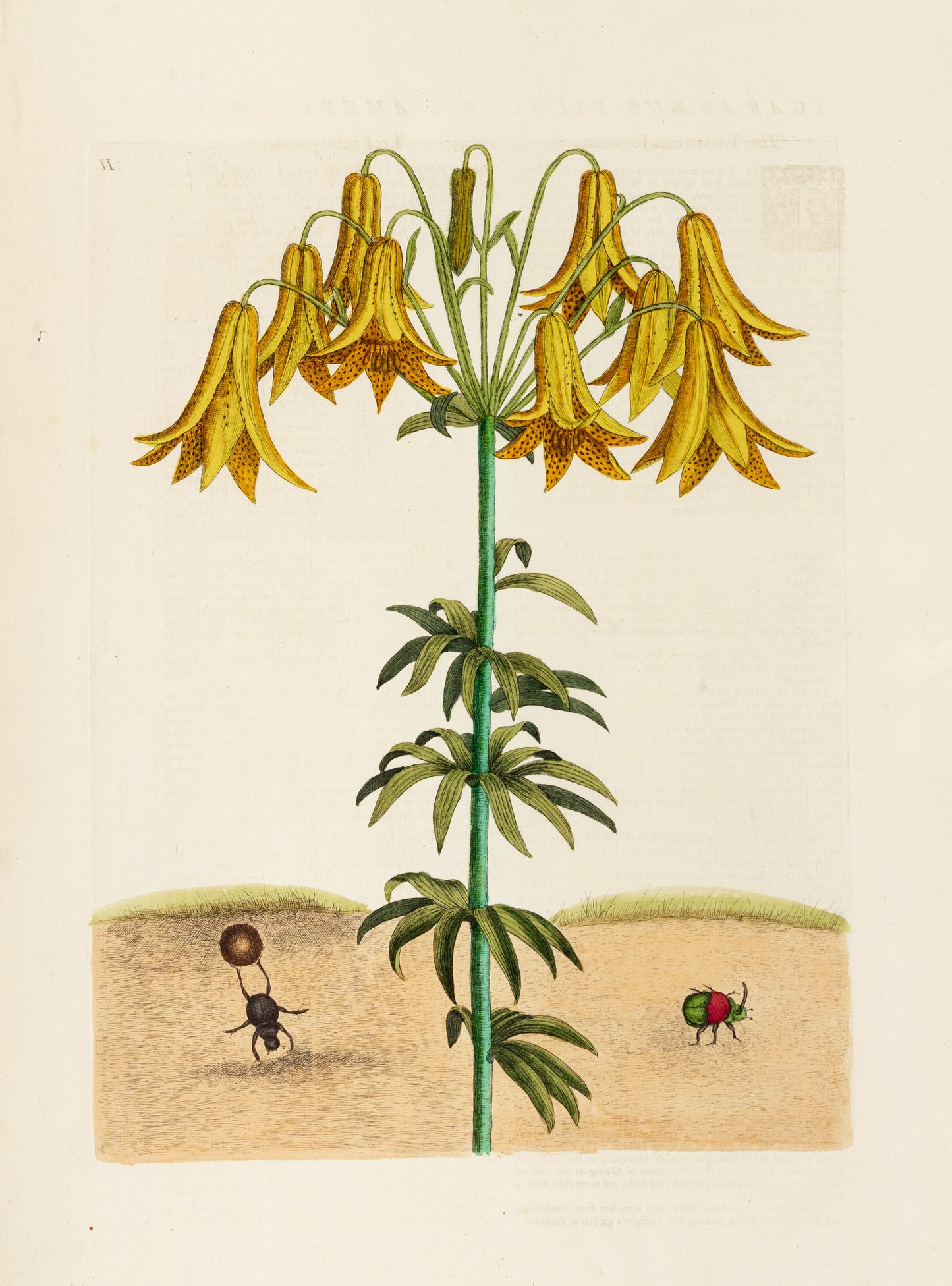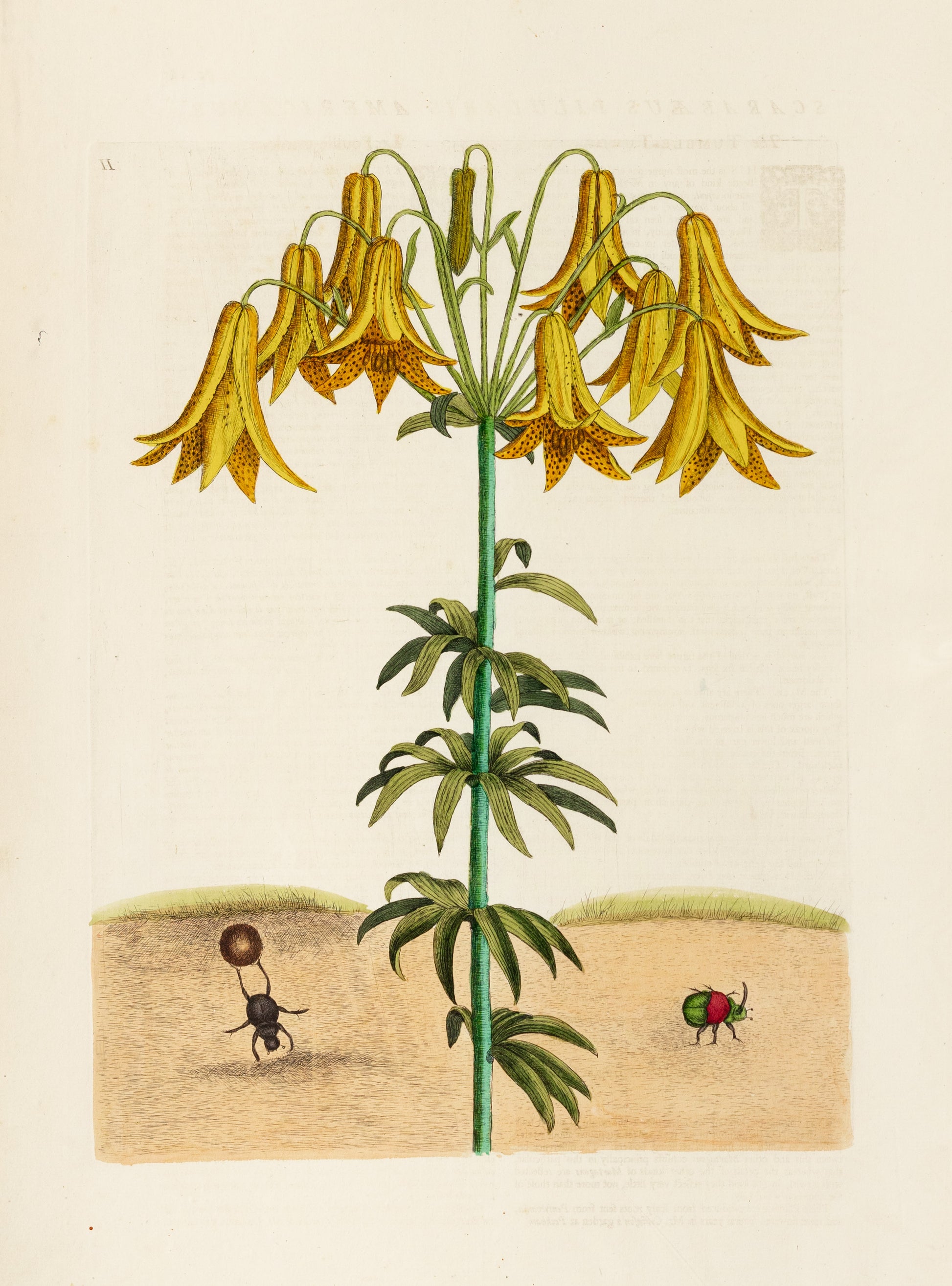Catesby, Mark. Appendix Pl. 11, The Tumble-Turds and Martagon Canadense
Catesby, Mark. Appendix Pl. 11, The Tumble-Turds and Martagon Canadense
Couldn't load pickup availability
Mark Catesby (1638 - 1749)
Etching with hand color, paper dimensions: approximately 19 x 14 inches
From the Appendix (Part 11) to Catesby's Natural History of Carolina, Florida & the Bahama Islands
London: 1747 - 1771
Currently known as the dung beetle, Canthon pilularius, rainbow scarab beetle, Phanaeus vindex, and Canada lily or meadow lily, Lilium canadenseI*, Catesby described these subjects as follows:
SCAROBAEUS PILULA RIS AMERICANUS.
The TUMBLE-TURDS.
This is the most numerous and remarkable of the Beetle kind of any in North- America. They appear in April, and continue the summer-months, or till about September, at which time they disappear, and are no more seen till the following Spring. Their constant employ, in which they are indefatigable, is, in order to continue their Species, to provide proper nidi to deposite their eggs; this they do by forming round pellets of human dung, or that of cattle, in the middle of which they lay an egg. These pellets, in September, they convey three feet deep in the earth, where they lie till the approach of Spring, when the eggs become animate, burst their nests, and find their way out of the earth. I have attentively admir'd their industry, and mutual assisting one another in rolling these globular balls from the place they made them to that of their interment, which is usually the distance of feme yards more or less; this they perform breech foremost, by raising their hind part, and forcing along the ball with their hind feet. Two or three are sometimes engaged in trundling one ball, which often meeting with impediments by the unevenness of the ground, is deserted by them, yet by others is again attempted with success; except it rolls into a deep hollow or chink, where they are necessitated to leave it, repeating the like action with the next ball that falls in their way. No one seems to know their own ball, but an equal care for all seem to affect the whole Community. They form these pellets while the dung remains moist, and leave them to harden in the sun before they attempt to roll them; in doing which, they and the balls are continually tumbling and rolling one over another down the little eminencies; but not discouraged thereby, repeat their attempts, and usually surmount these difficulties.
These Insects being endowed with the like sagacity of the Turky-buzzard (Vol. I. p. 6.) find out their subsistence by the excellency of their noses, which direct them in flights to the excrement just fallen from Man or Beast, on which they instantly drop, and fall unanimously to work in forming balls, &c. which they temper with a mixture of earth. So intent they are at their work, that tho' handled, or otherwise interrupted, they persist in their oeconomical employment without apprehension of danger.
The size of it is that of the figure here exhibited. It is all over of a dusky black. It has six legs, two joined to the thorax, and four to the abdomen.
The MALE. There are always accompanying these just mentioned, some larger ones of a different and more elegant structure and colour, which are much less numerous, being about one in twenty to the others. The thorax of this is covered with a shield of a crimson metallick lustre, the head and lower part of the shield of the like lustre, blended with green. From the crown of the head rises a shining black horn recurved backward. The sheaths of the wings are ribbed, and of a shining deep green; as are the thighs and under-part of the abdomen. These are commonly called King Tumble-Turds, tho' by what appears they assume no preeminence, but without distinction partake of the like dirty drudgery with the rest.
I think this can be no other than the Male of that first described, not- withstanding the great difference that appears in their outer structure and colour, and the disparity of number.
N. B. It is certain that Pliny, from Aristotle, has made mention in his Nat. Hist. Book XI. Chap. 23. of a kind of Beetles who roll large balls of dung with their feet backwards, and lodge therein against the rigour of the Winter, small worms, which become their young ones; others fly, &c. But as neither of them have given us a particular description of this Species, it is hardly possible to determine if those in America are precisely the same as those mentioned by these two Authors. Î shall add to this remark, which I received from the reverend and learned Mr. Durand, That I received one of these Beetles from Gibraltar, with its ball, very different from those of America, from which I conjecture that the Gibraltar sort is probably that of Aristotle.
Aliud rursus corun genus, qui è simo ingentes pilas aversi pedibus volutant, parvosque in iis contra rigorem hiemis vermiculos fui foetus nidulantur: voutant alii, &c.
Hist. Nat. L. XI. S. 34. Ed. Hard.
Et Arist. Hist. Anim. Lib. 5. Cap. 18. Hi pilularii dicti, quod stercus volutant, in quo condunt se per hiemem, vermiculosque pariunt, unde Scarabaei proveniunt.
Lilium sive Martagon Canadense, floribus magis flavis, non reflexis.
This singular Kind of Martagon rises to the height of almost four feet. On the summit of the stem are set altogether, about twelve pedicles, to which are fix'd its reclining flowers. The difference between this and other Martagons consists principally in this particular, that whereas the petals of the other kinds of Martagons are reflected with a twirl, in this kind they reflect very little, not more than those of the common white Lily. These Plants were produced from scaly roots sent from Pensylvania and have flowered several years in Mr. Collinson's garden at Peckham.
Mark Catesby (1683 – 1749)
Facts regarding Catesby’s early years are scant. It is known that he was born in the ancient market town of Sudbury, England to a father who was a legal practitioner and mayor of Sudbury and to a mother from an old Essex family. It seems that he received an understanding of Latin and French and was familiar with the eminent naturalist Reverend John Ray. Following his father’s death, he was endowed with the means to pursue his interest in the natural history of North America.
Catesby arrived in Virginia in 1712 as the guest of his sister and her husband, Dr. William Cocke, an aid the Governor of the colony. Soon he was acquainted with the well-connected William Byrd, a Fellow of the Royal Society whose diary contains passages discussing Catesby’s strong curiosity with all things relating to North America.
This included plants native to the fields and woods of Virginia through which Catesby traveled, collecting examples of botanical specimens unfamiliar in England, which he illustrated and sent back to his uncle, Nicholas Jekyll and the apothecary and botanist, Samuel Dale.
Catesby’s first trip to the New World was extensive and included a visit to Jamaica. Although he felt that his approach to a larger understanding of its natural history was lacking in structure, his experience would inform his future expeditions.
Following his return to London in 1719 Catesby resolved to return to the colonies and gather additional information for his illustrated Natural History... He gained the financial support of members of the local scientific community, many of who were members of the Royal Society keen to send a naturalist to Carolina who could provide an accurate account of its resources. Among those who belonged to the Royal Society was William Sherard, who after examining Catesby’s drawings, was key in advancing the project. With further backing by Sir Hans Sloane, court physician and naturalist whose collection would form the basis for The British Museum, Catesby sailed to Carolina in 1722.
Catesby’s four years of travels following his second arrival in North America brought him throughout South Carolina, parts of Georgia, and the Bahamas. He was
intent on visiting the same location at different times throughout the year in order to observe his subjects as they developed. In addition to gathering botanical specimens of potential horticultural importance, he also acquired birds and other creatures.
Catesby’s patrons in London were eager to receive examples of the varieties of plants and animals he encountered but collecting, packaging, and sending them back to England served as a distraction to his intended Natural History... Nevertheless, he continued to observe, paint, and write descriptions of the previously un-investigated wildlife he encountered on the shores and in the swamps, woods, and fields of the middle American colonies.
Catesby returned to England from his final voyage to America in 1726 and spent the next seventeen years preparing his Natural History... He envisioned his work containing colored plates reproducing his studies from nature in a substantial, folio-sized format, an achievement nearly unprecedented in earlier natural history publications. Catesby arranged for financing in the form of an interest-free loan from the Quaker Peter Collinson, a fellow of the Royal Society. Nevertheless, the cost of paying professionals to prepare his delineations on copper plates for printing was too great. To this end, with the assistance of Joseph Goupy (1689–1769), a French artist living in London, he taught himself to etch. In addition to producing nearly all of the plates for his publication, Catesby closely supervised the coloring of the engravings, either painting the impressions himself or closely overseeing the work to insure its fidelity to his preparatory work. To further finance the project Catesby sold subscriptions, offering his book in sections of 20 plates to be published every four months.
The first volume of Natural History of Carolina, Florida & the Bahama Islands, containing one hundred plates, was completed in 1731 and no doubt facilitated his election as a fellow of the Royal Society in February, 1733. The second volume, also containing one hundred plates, was finished in 1743 and was supplemented with twenty plates based on information sent to Catesby by John Bartram and others in in America appeared in 1746–1747. Of the approximately 180 - 200 copies of the first edition produced, roughly 80 copies remain complete and accounted for and there are an unknown number in private collections. A second edition was issued by George Edwards in 1754 and a third edition, published by Benjamin White, in 1771 who continued to print examples of the plates until at least 1816. As early as 1749 editions were produced for the European market with translations of the text in German, Latin, and Dutch. In these the plates for the first volume and appendix were re-etched by Johann Michael Seligmann and the plates for the second volume re-etched by Nicolaus Friedrich Eisenberger and Georg Lichtensteger.
Catesby’s tenacity resulted in a sweeping and compelling study of American plants, animals, and marine life native to little documented lands in which he strove to assign scientific nomenclature to his subjects. Indeed, Linnaeus, in his 1758 Systema Naturae, made use of much information brought to light by Catesby using it as the foundation of his system of binomial nomenclature for American species.
Throughout the production of his Natural History…Catesby lived in London with his Elizabeth Rowland with whom he had four children and married in 1747, before his death in 1749.
*From James L. Reveal’s Identification of the plants and animals illustrated by Mark Catesby for The natural history of Carolina, Florida and the Bahama islands in the appendix of The Curious Mr. Catesby, University of Georgia Press.
>

